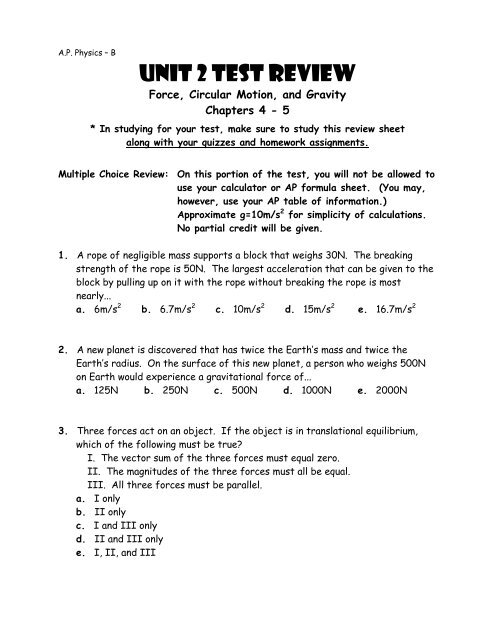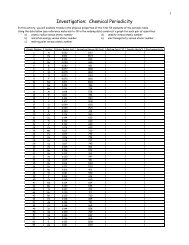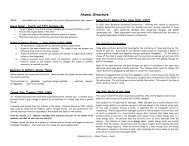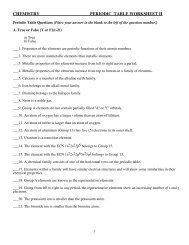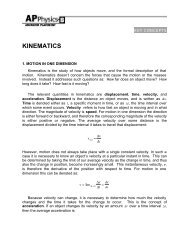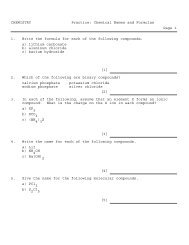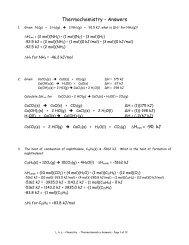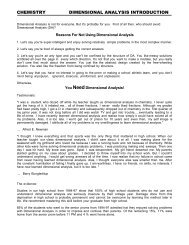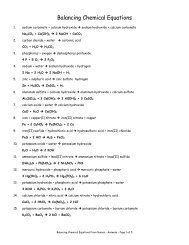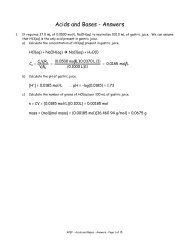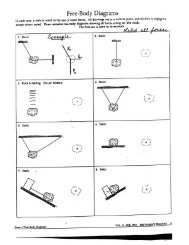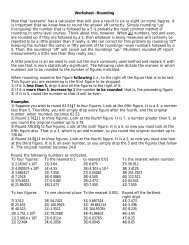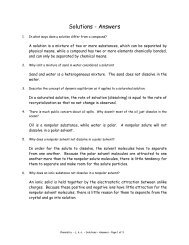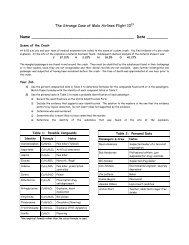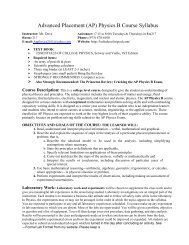2nd Year Physics â 1
2nd Year Physics â 1
2nd Year Physics â 1
You also want an ePaper? Increase the reach of your titles
YUMPU automatically turns print PDFs into web optimized ePapers that Google loves.
A.P. <strong>Physics</strong> – B<br />
Unit 2 Test Review<br />
Force, Circular Motion, and Gravity<br />
Chapters 4 - 5<br />
* In studying for your test, make sure to study this review sheet<br />
along with your quizzes and homework assignments.<br />
Multiple Choice Review: On this portion of the test, you will not be allowed to<br />
use your calculator or AP formula sheet. (You may,<br />
however, use your AP table of information.)<br />
Approximate g=10m/s 2 for simplicity of calculations.<br />
No partial credit will be given.<br />
1. A rope of negligible mass supports a block that weighs 30N. The breaking<br />
strength of the rope is 50N. The largest acceleration that can be given to the<br />
block by pulling up on it with the rope without breaking the rope is most<br />
nearly...<br />
a. 6m/s 2 b. 6.7m/s 2 c. 10m/s 2 d. 15m/s 2 e. 16.7m/s 2<br />
2. A new planet is discovered that has twice the Earth’s mass and twice the<br />
Earth’s radius. On the surface of this new planet, a person who weighs 500N<br />
on Earth would experience a gravitational force of...<br />
a. 125N b. 250N c. 500N d. 1000N e. 2000N<br />
3. Three forces act on an object. If the object is in translational equilibrium,<br />
which of the following must be true?<br />
I. The vector sum of the three forces must equal zero.<br />
II. The magnitudes of the three forces must all be equal.<br />
III. All three forces must be parallel.<br />
a. I only<br />
b. II only<br />
c. I and III only<br />
d. II and III only<br />
e. I, II, and III
4. What is the orbital speed of a satellite of mass m orbiting the earth at a<br />
distance r from the center of the Earth? (Assume that G stands for the<br />
gravitational constant and M stands for the Earth’s mass.)<br />
a.<br />
GM<br />
r<br />
b.<br />
2GM<br />
r<br />
c.<br />
2Gm<br />
r<br />
d.<br />
2Gm<br />
r<br />
5. A child has a toy tied to the end of a string and whirls the toy above his head<br />
at a constant speed in a horizontal circular path of radius R. The toy<br />
completes each revolution of its motion in a time period T. What is the<br />
magnitude of the acceleration of the toy?<br />
a. Zero b.<br />
2<br />
4π<br />
R<br />
2<br />
T<br />
πR<br />
c.<br />
2<br />
T<br />
e.<br />
GM<br />
r<br />
d. g e. 2 π g<br />
6. Three objects can only move along a straight, level path. The graphs below<br />
show the position d of the objects plotted as a function of time t. The sum of<br />
the forces on the object is zero in which of the cases?<br />
d d d<br />
I<br />
t t t<br />
II<br />
III<br />
a. II only<br />
b. III only<br />
c. I and II only<br />
d. I and III only<br />
e. I, II, and III<br />
5N<br />
7. A 2kg block slides with constant velocity along a<br />
horizontal tabletop. A horizontal applied force<br />
of 10N and a downward applied force of 5N act<br />
10N<br />
on the block, as shown. The coefficient of<br />
friction between the block and tabletop is most<br />
nearly...<br />
a. 0.3 b. 0.4 c. 0.5 d. 0.75 e. 1
8. A 2kg object is released to slide down a 20 o incline. If the coefficient of<br />
kinetic friction between the object and incline is 0.4, the object will accelerate<br />
down the incline at a rate of...<br />
a. (0.4)(2g)<br />
b. (0.4)(2g)<br />
2kg<br />
2<br />
o<br />
(0.4)(2g)(cos20 )<br />
c.<br />
2<br />
20 o<br />
o<br />
o<br />
(2g)(sin20 ) − (0.4)(2g)(cos20 )<br />
d.<br />
2<br />
o<br />
o<br />
(0.4)(2g)(cos20 ) − (2g)(sin20 )<br />
e.<br />
2<br />
Questions 9 and 10:<br />
A steel ball supported by a stick is attached<br />
to a rotating cylinder, and itself rotates in a<br />
circle of radius r, as shown.<br />
r<br />
9. The direction of the net force acting on<br />
the ball when it is in the position shown<br />
is indicated by which of the following?<br />
a.<br />
b. d.<br />
c. e.<br />
10. If the ball becomes disconnected from its supporting stick at the position<br />
shown in the diagram above, it will become a projectile with an initial velocity<br />
in which direction?<br />
a. straight upward d. to the right<br />
b. straight downward e. to the left<br />
c. out of the plane of the page
Problem Review: On this portion of the test, you may use your calculator, AP<br />
formula sheet, and AP table of information. Partial credit<br />
will be given on these problems.<br />
11. The 100N light fixture in the figure is at rest. Find the tension in the two<br />
wires that support the fixture<br />
32 o<br />
Wire 1<br />
45 o<br />
Wire 2<br />
12. The coefficient of static friction between a 3kg crate and the 35 o incline it<br />
sits upon is 0.200. This friction is not enough to keep the box from sliding<br />
down the incline. What is the minimum ‘squeezing’ force that must be applied<br />
to the box, perpendicular to the incline, to keep the crate from sliding?<br />
13. An airplane accelerates uniformly from rest. A physicist passenger holds up a<br />
thin string of negligible mass to which she has tied her ring and notices that<br />
the string makes an angle with the vertical. If the plane reaches a takeoff<br />
speed of 65m/s after accelerating for a total of 30s, determine the angle θ<br />
that the string makes with the vertical during the acceleration of the plane<br />
before it leaves the ground.
14. The two blocks in the picture are being held in place, and are then released<br />
from rest. Use force ideas and kinematics to find the following, assuming the<br />
table and pulleys are frictionless: the tension in the cord connecting the<br />
blocks, the acceleration of the 3kg block as it descends, and the speed of the<br />
3kg block as it strikes the floor, 1.2m below where it started.<br />
9 kg<br />
3 kg<br />
15. A 15cm-radius Beatles album spins at 78 rev/min. What are the magnitude and<br />
direction of the acceleration of a dust particle sitting at the album’s outer<br />
edge?<br />
16. A 2000kg car rounds a circular turn of radius 30m. If the road is flat and the<br />
coefficient of static friction between the tires and road is 0.67, what is the<br />
fastest velocity the car can have as it rounds the corner without skidding?
17. A roller-coaster car has a mass of 600kg when fully loaded with passengers.<br />
The vehicle is approaching the top of a hill that is shaped like part of a circle<br />
of radius 20m. What is the maximum speed the car can have when it is at the<br />
top of the hill, in order for gravity to keep the car on the track?<br />
Body Mass (kg) Mean Radius (m) Distance from Sun (m)<br />
Earth 5.98x10 6.37x10 6 1.496x10 11<br />
Sun<br />
30<br />
1.991x10 6.96x10 8 --<br />
Moon 7.36x10 22 6<br />
1.74x10 --<br />
* Distance from the Earth to the Moon = 384,000 km<br />
18. Use the given information in the table to determine the orbital speed of the<br />
Moon around the Earth, as well as the period of orbit of the Moon.
19. Actual A.P. <strong>Physics</strong> B Free-Response Question (2000):<br />
v<br />
m 2<br />
θ<br />
m 1<br />
M<br />
Blocks 1 and 2 of masses m 1 and m 2 , respectively, are connected by a light string.<br />
These blocks are further connected to a block of mass M by another light string<br />
that passes over a pulley of negligible mass and friction. Blocks 1 and 2 move with<br />
a constant velocity v down the inclined plane, which makes an angle θ with the<br />
horizontal. The kinetic frictional force on block 1 is f and that on block 2 is 2f.<br />
a. On the given figure, draw and label all the forces on block m 1 .<br />
m 1<br />
θ<br />
Express your answers to each of the following in terms of m 1 , m 2 , g, θ , f.<br />
b. Determine the coefficient of kinetic friction between the inclined plane and<br />
block 1.<br />
c. Determine the value of the suspended mass M that allows blocks 1 and 2 to<br />
move with constant velocity down the plane.<br />
d. The string between blocks 1 and 2 is now cut. Determine the acceleration of<br />
block 1 while it is on the inclined plane.
20. Actual A.P. <strong>Physics</strong> B Free-Response Question (2001):<br />
Z<br />
M<br />
R<br />
Side View:<br />
P<br />
Q<br />
A ball of mass M is attached to a string of length R and negligible mass. The ball<br />
moves clockwise in a vertical circle, as shown above. When the ball is at point P,<br />
the string is horizontal. Point Q is at the bottom of the circle and point Z is at the<br />
top of the circle. Air resistance is negligible. Express all algebraic answers in<br />
terms of the given quantities and fundamental constants.<br />
a. On the figures below, draw and label all the forces exerted on the ball when it<br />
is at point P and Q, respectively.<br />
P<br />
Q<br />
b. Derive an expression for v min , the minimum speed the ball can have at point Z<br />
without leaving the circular path.<br />
c. The maximum tension the string can have without breaking is T max . Derive an<br />
expression for v max , the maximum speed the ball can have at point Q without<br />
breaking the string.<br />
d. Suppose that the string breaks at the instant the ball is at point P. Describe<br />
the motion of the ball immediately after the string breaks.
Unit 2 Test Review Answers:<br />
1. b 2. b 3. a 4. e 5. b<br />
6. c 7. b 8. d 9. e 10. c<br />
11. T<br />
1<br />
cos 32 = T2<br />
cos 45 so T1<br />
= 0.834T2<br />
Also, T1 sin 32 + T2<br />
sin 45 = 100 , so<br />
substitution<br />
gives (0.834T<br />
2) sin 32 + T2 sin 45 = 100<br />
Therefore, T2 = 87N and T1<br />
= 72.6N<br />
Fs<br />
3(9.8) sin35<br />
12. FN<br />
= = = 84.3N , so Fapp = FN<br />
− Fgy<br />
= 60.2N<br />
μs<br />
.2<br />
13. The acceleration of the plane (and ring) is found by a = 65 − 0 = 2.17m/s 2 .<br />
30<br />
To calculate the angle of the string, think about the two components of the<br />
tension force in the string. The x-component is causing the acceleration, T x =<br />
ma. The y-component is balancing out the weight of the ring, so T y = mg. So<br />
θ = tan -1 (ma/mg) = 12.5 o<br />
14. On the table, T=9a. For the block hanging over the side, 29.4-T=3a.<br />
2<br />
Substitution gives a = 2.45m / s so T = 22.05N. Then the block’s<br />
2 2<br />
final speed is found with v = v + 2ax to be v = 2.43m/s.<br />
o<br />
15. First convert 78rpm to 1.225m/s. Then find the centripetal acceleration by<br />
2<br />
v<br />
ac = = 10.0m/s 2 . The direction of the acceleration is toward the center<br />
r<br />
of the circular path.<br />
16. For the car not to skid, friction must cause the centripetal acceleration, so<br />
2<br />
v<br />
Ffric<br />
= m(ac<br />
). Ffric<br />
=μ FN<br />
= 13,132N. So the equation Ffric<br />
= m yields r<br />
v = 14.03m/s.<br />
17. For the car to stay on the track, gravity must provide the force causing the<br />
centripetal acceleration (with F N =0 to imply that the car is almost ready to<br />
2<br />
v<br />
leave the track). So, Fg<br />
= m yields a speed of 14 m/s.<br />
r<br />
18. Gravity must be the cause of the centripetal acceleration, F g = m , but F g is<br />
found with Newton’s Universal Law of Gravitation. This yields the expression<br />
GmEarth<br />
v = which gives an orbital speed of 1019m/s. The period is<br />
8<br />
3.84 × 10<br />
d 2πr<br />
found with the equation v = =<br />
6<br />
which gives T= 2.37 × 10 s , or approx.<br />
t T<br />
27.4 days.<br />
a c
19.a.<br />
N<br />
f<br />
m 1<br />
T 1<br />
m 1 g<br />
F<br />
b.<br />
fric<br />
f<br />
μ= and N = F gy = mgcos θ , so μ=<br />
N<br />
mgcos<br />
1<br />
θ<br />
c. Considering the entire system all at once, the forward forces (xcomponents<br />
of weight of blocks on the incline) are balanced with the<br />
backwards forces (friction and the weight of the hanging block).<br />
mgsin<br />
1<br />
θ+ mgsin<br />
2<br />
θ= Mg+ f+<br />
2f<br />
3f<br />
Solve for M = sin θ (m1 + m<br />
2)<br />
−<br />
g<br />
d. If the string is cut, block 1 will move down the incline under the influence of<br />
gravity and friction. Using Newton’s 2 nd Law: mgsin<br />
1<br />
θ − f=<br />
ma<br />
1<br />
mgsin<br />
1<br />
θ−f f<br />
and a = = gsinθ−<br />
m<br />
m<br />
1 1<br />
20.a.<br />
P<br />
T<br />
T<br />
Q<br />
Mg<br />
b. At point Z, using Newton’s 2 nd law:<br />
Mg<br />
2<br />
v<br />
Mg + T = M R<br />
But T=0 because you’re finding the minimum speed to stay in a circle, which<br />
would be the moment when the string becomes ‘un-tense’.<br />
Solve for v = gR<br />
c. At point Q using Newton’s 2 nd 2<br />
v<br />
law: T − M g = M R<br />
TR<br />
Solve for v = gR<br />
M −<br />
d. It will continue straight upward, behaving as a vertically-launched free-fall<br />
object.


